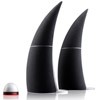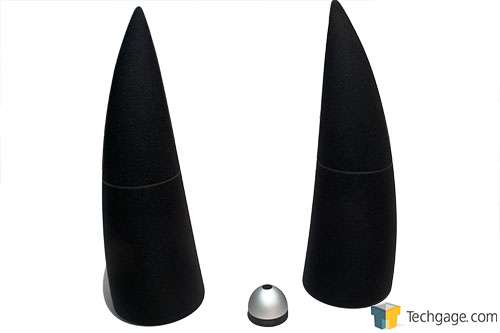- Qualcomm Launches Snapdragon 4 Gen 2 Mobile Platform
- AMD Launches Ryzen PRO 7000 Series Mobile & Desktop Platform
- Intel Launches Sleek Single-Slot Arc Pro A60 Workstation Graphics Card
- NVIDIA Announces Latest Ada Lovelace Additions: GeForce RTX 4060 Ti & RTX 4060
- Maxon Redshift With AMD Radeon GPU Rendering Support Now Available
Edifier Spinnaker Bluetooth Speakers Review

It’s been a long time since we reviewed anything from Edifier, but with the recent release of the Spinnaker speakers, they were hard to resist. We decided to grab the bull by the horns and take them for a spin. With an eye-catching design, puns out of the way and wireless to boot, will these speakers catch your ear as well as your eyes?
Page 2 – Testing, Final Thoughts
Audio quality was definitely at the forefront of the Spinnaker design. Triple amplified digital crossovers are not cheap to implement, but it certainly makes a difference to the soundstage. Separating frequency bands means that there is less distortion as a result of the speakers trying to produce frequencies they were not designed for (it’s very difficult to get a 4" speaker to produce high frequencies reliably and to keep them balanced). The result is equal clarity in all frequency ranges without certain bands becoming muddy, washed-out or over-emphasized (maintaining that ±3dB – for the most part).
Surprisingly, for a 4" woofer, bass performance was exceptional, even if a little too pronounced. This is quite noticeable at lower volumes as the higher mid and treble struggle to overcome the strong bass. As volume is increased to average listening levels, it all balances out quite well. With that in mind, these speakers are best placed at least a meter away. Moving into the sub levels, then things become quite muddy with very little difference in tone; kick drums all merge together with no definitive thud, and this is reflected in the frequency response. If you want low end bass, you’ll need to use the dedicated sub-output port.
The rounded face of the speakers does mean pinpointing the direction of the cones is a little difficult, since you cannot see them, so setting up for accurate stereo separation is equally tricky and will require a little bit of a trial.
Optical input does introduce its quirks. System volume will not always have an effect and the speakers will have its own independent volume level – which leads into the second issue. The Spinnakers have no memory between power cycles, so it defaults to a particular volume level – that just so happens to be quite loud. This can be very startling and certainly woke me up in the morning (and probably the neighbors).
This is also when a mild oversight rears its head – there is no way to tell how loud the speakers are as there is no visual indicator on either the speakers or the remote to show you the current volume setting. The remote flashes when changing volume or tracks via Bluetooth, but offers no other information.
Testing
With much of the physicalities exposed, it’s time for some discerning listening. To be clear, I’m not one to list every song and artist I play through these speakers (there are simply too many). I listen to whatever mood takes me, encompassing a wide range of genres from classical, jazz, rock, industrial, power metal and almost anything in between. I prefer a more analytical approach to audio than trying to describe nuance with flowery words to a sense that is impossible to adequately express in a meaningful manner. Sound is subjective and as always, if you are interested in a set of speakers, listen to them first before committing, especially when dealing with $300+ price range. With that said, I will express strengths and weaknesses of the soundstage.
Going through either optical or AUX jack inputs, sound quality is extremely pleasing and I do need to stress the clarity offered as a result of the crossover, much to the same effect as the Corsair SP2500. It’s very hard to overstate the difference crossovers can make, with much of the clarity being in the upper ranges. Cymbal strikes are concise and sharp, and reverb from live recordings are pushed into the room, really opening up an ambience that is often lost with speakers. As described earlier in the review, some of the bass frequencies can be a little over-powering, with that strong resonance in the 80Hz range.
When listening to vocals and the low-mid range, the resonance can be somewhat distracting. Since this is an artifact of the speaker design, it’s not something easily corrected with EQ adjustments. This range is rather small though and it’s only certain specifically tuned harmonics that can play on this resonance (deep male voices and a guttural distorted electric guitar). Past this and everything responds well. It would be worth figuring out a dedicated sub-woofer, as deep bass is completely lost on the 4" woofers. Edifier does need to be commended with its honest range specifications. Overall, music is well balanced with the only complaint being the resonance. Definitely an enjoyable experience and I do need to re-emphasise the clarity from the tweeter.
Unfortunately, the clarity that is inherently present evaporates when using Bluetooth. This is not the fault of the speakers, but of Bluetooth itself. Despite the use of a high bit-rate codec (360kbps+), some fidelity is lost in transmission. The fact it’s noticeable is a testament to the speakers reproductive capabilities. This is not to say that Bluetooth sounds terrible, it’s just not the same as with a dedicated wired input. For mobile devices though, this should be more than adequate. Comparing these speakers to one of these ubiquitous ‘docks’ would just be insulting, but this is to be expected in this price range.
Final Thoughts
So how to wrap this up? There is no denying the quality of the audio and the shape is certainly unique, but there are still a couple issues to contend with. No visual indicator for volume and no memory for last volume level means that turning the speakers off for the night could lead to a very startling awakening in the morning. The proprietary cable used to connect both speakers could also introduce a point of contention with limited availability of a replacement or longer cable. Bluetooth may not be quite up to par with a wired connection, but it’s quality is still excellent and a far cry from wireless of old.
There were no audible tell-tale signs of noise at various volumes, everything is isolated well, no hiss and such. The triple crossover does wonders for fidelity, with this again not introducing any kind of noise (often common with digital crossovers). The Bluetooth priority system does make connecting mobile devices easier, just be sure to check for auto-discovery issues as I did.
Recommending these mainly comes down to personal preference given the price-range, and the shape won’t be for everyone. If you are looking for a pair of eye-catching, high audio quality wireless speakers, the Spinnakers would certainly fulfil that role. The Spinnakers are available from the Apple store and other retailers for around $350 or £320.
Pros
- Exceptional Audio Quality
- Digital Crossover
- Unique Shape and Style
- Wireless
- Multiple Inputs
Cons
- No Volume Indication
- No Volume Memory
- Proprietary 6-pin Cable
Discuss this article in our forums!
Have a comment you wish to make on this article? Recommendations? Criticism? Feel free to head over to our related thread and put your words to our virtual paper! There is no requirement to register in order to respond to these threads, but it sure doesn’t hurt!
Support our efforts! With ad revenue at an all-time low for written websites, we're relying more than ever on reader support to help us continue putting so much effort into this type of content. You can support us by becoming a Patron, or by using our Amazon shopping affiliate links listed through our articles. Thanks for your support!






